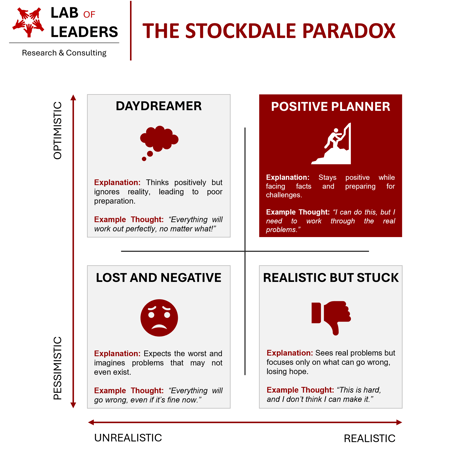The Stockdale Paradox: The Mindset That Transforms Challenges into Triumphs
In a world where obstacles and uncertainties test our resolve daily, how do some individuals and organizations not just survive but thrive? The answer lies in the Stockdale Paradox — a profound concept that redefines the way we approach adversity. If you’re tired of quick fixes and need a powerful mindset to elevate your personal and professional life, this is the perspective you’ve been looking for.
Abdullah MAQ
12/21/20243 min read


What Is the Stockdale Paradox?
The Stockdale Paradox is named after Admiral James Stockdale, a U.S. naval officer who endured over seven years as a prisoner of war in Vietnam. Despite unimaginable hardships, Stockdale survived by striking a balance between two seemingly contradictory principles:
Unwavering faith in eventual success.
The brutal acceptance of current realities.
Stockdale didn’t sugarcoat his dire circumstances, but he also didn’t lose hope. His unique mindset kept him grounded and optimistic, enabling him to endure adversity and emerge stronger.
In Jim Collins’ groundbreaking book Good to Great, this paradox was highlighted as a critical factor in distinguishing companies that excelled over the long term. The Stockdale Paradox isn’t just a survival tactic—it’s a framework for navigating any challenge.
The Four Quadrants of Mindset
To understand how the Stockdale Paradox operates, it helps to visualize four distinct mindsets based on optimism, realism, and action. The framework includes:
1. Daydreamer
Mindset: Excessively optimistic but detached from reality.
Result: Poor preparation and inevitable failure.
Example Thought: “Everything will work out perfectly, no matter what!”
2. Positive Planner
Mindset: Balances optimism with realism, taking proactive steps to address challenges.
Result: Effective problem-solving and long-term success.
Example Thought: “I can do this, but I need to work through the real problems.”
3. Lost and Negative
Mindset: Pessimistic and paralyzed by imagined fears.
Result: Inaction and self-fulfilling failure.
Example Thought: “Everything will go wrong, even if it’s fine now.”
4. Realistic but Stuck
Mindset: Clear about problems but lacks the belief or drive to overcome them.
Result: Stagnation and missed opportunities.
Example Thought: “This is hard, and I don’t think I can make it.”
The magic happens when you step into the Positive Planner quadrant, where the principles of the Stockdale Paradox come alive.
Why the Stockdale Paradox Matters in Leadership and Business
Whether you’re leading a team, running a business, or navigating personal challenges, the Stockdale Paradox offers invaluable lessons:
Boosting Resilience: Acknowledging reality while staying hopeful creates mental toughness to weather crises.
Driving Strategic Decisions: It prevents overconfidence while empowering you to take calculated risks.
Fostering Trust: Teams rally around leaders who face facts yet inspire hope.
Building Long-Term Success: The paradox keeps you focused on sustainable solutions, not quick wins.
Applying the Stockdale Paradox in Your Life
Here are actionable steps to embrace this transformative mindset:
1. Face the Brutal Facts
Don’t sugarcoat your challenges. Whether it’s financial trouble, health setbacks, or organizational issues, confront reality with clarity.
Ask Yourself: What is the worst-case scenario? What data supports this?
Action: Create a list of the most pressing issues you need to address.
2. Cultivate Unshakable Faith
Simultaneously, nurture a deep belief that you will prevail in the end.
Ask Yourself: What is my ultimate goal? Why is it worth fighting for?
Action: Write down your vision for success and revisit it daily.
3. Develop a Plan
Optimism without action is futile. Break down your goals into manageable steps.
Ask Yourself: What can I do today to move closer to my goal?
Action: Implement one small improvement every day, no matter how challenging it feels.
4. Monitor Your Mindset
Regularly assess whether you’re drifting into unhelpful thought patterns.
Ask Yourself: Am I ignoring facts or losing hope?
Action: Use tools like journaling, mindfulness, or feedback from trusted peers to stay grounded.
Conclusion: Embrace the Stockdale Paradox for Unstoppable Growth
Life will always throw challenges your way, but how you respond determines your trajectory. The Stockdale Paradox isn’t just about surviving—it’s about thriving in the face of adversity. By balancing optimism with realism, you’ll discover the strength to overcome obstacles and achieve lasting success.
Are you ready to adopt the mindset of a Positive Planner? Start today by facing the facts, believing in your success, and taking action. The results will speak for themselves.
LAB OF LEADERS
Finding What Works, Simplified For Leaders
Contact Us
+601125101301
© 2024. All rights reserved.
